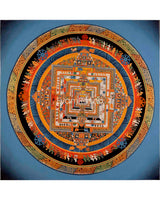
Kalachakra Mandala Tibetan Thangka | Zen Buddhism

100% AUTHENTIC

HANDMADE

FREE SHIPPING
Kalachakra Mandala Tibetan Thangka
About Out Thangka
The sacred and complicated thangka known as the Kalachakra mandala illustrates the cosmology and teachings of the Kalachakra tantra in Tibetan Buddhism. The universe and its endless cycles of birth, death, and rebirth are represented by the Kalachakra mandala.A central god, Kalachakra, is frequently depicted in thangka paintings, and is surrounded by several other deities, symbols, and elaborate geometric patterns that signify various facets of the cosmos and its cycles. As the embodiment of time and a symbol of the cycle of life, death, and rebirth, the Kalachakra deity is revered.The Kalachakra mandala thangka is a tool for meditation and visualization in Tibetan Buddhist practices and rites. It's vivid hues and fine details are not only lovely but also have significant symbolic importance.
------------------------------------------------------------------
Size: 17"/ 43 cm (width) x 17"/ 43cm (height)
Materials: Cotton Canvas, Acrylic Colors, Genuine 24K Gold
------------------------------------------------------------------
THIS THANGKA IS HAND-PAINTED IN THE TRADITIONAL STYLE AND THE QUALITY IS HIGH
------------------------------------------------------------------
Introduction To The Thangka :
The mantra here refers to the recitation of the essential words of the particular rituals of deities. When the word mantra is separated into two segments, it reveals the inner meaning of salvaging one's mind from conceptualization, concept, and fear. "Man" in Sanskrit means mind, and "tra" in Sanskrit means to protect. "om mani Padme hum" the six syllables, om mani pad me hum, mean that in dependence on the practice of a path which is an indivisible union of method and wisdom, you can transform your impure body, speech, and mind into the pure exalted body, speech, and mind of a Buddha.
How to take care of your thangka?
-Hang your thangka in a traditional silk brocade
-Regular Inspection of your thangka; examine the borders and all attachments.
-Keep thangkas covered when they are on display but not in use.
-Rotate thangkas between display and storage on a regular basis, two to four times a year, to reduce the amount of exposure to light. Keep away from sunlight and humidity.
-Do not apply liquids or other materials to the surface of the thangka.
Shipping & Returns
We ship worldwide. Orders dispatch in 2–3 business days. International delivery typically arrives in 4–10 business days via DHL Express, depending on destination and carrier conditions. All items ship free globally.
Returns are accepted within 14 days of delivery. Products must be returned in original condition for a refund to be issued once received and inspected. Terms and conditions apply.











